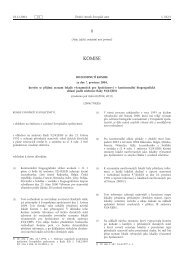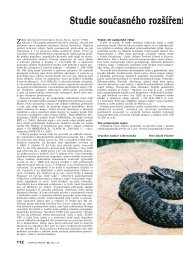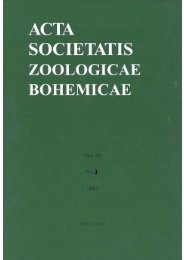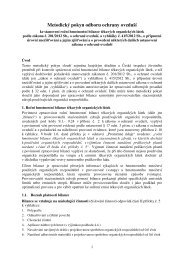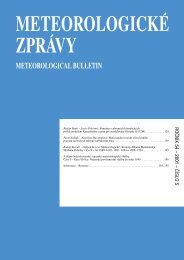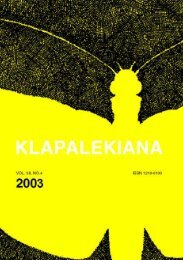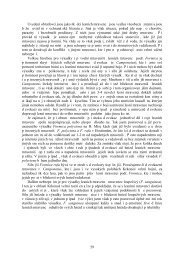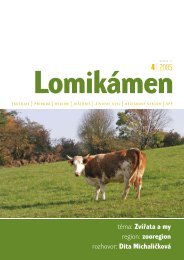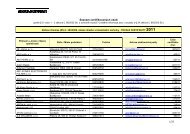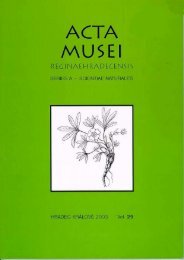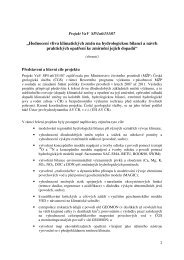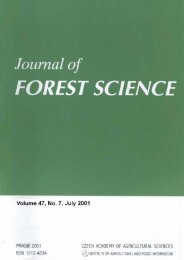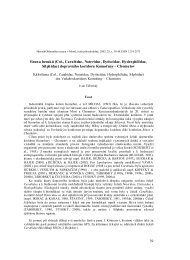Distribution and taxonomy of some Synapsis species, with ...
Distribution and taxonomy of some Synapsis species, with ...
Distribution and taxonomy of some Synapsis species, with ...
You also want an ePaper? Increase the reach of your titles
YUMPU automatically turns print PDFs into web optimized ePapers that Google loves.
BOOK REVIEW<br />
Acta Soc. Zool. Bohem. 66: 329–330, 2002<br />
ISSN 1211-376X<br />
BERAN L.: Vodní m"kkýši #R. Metodika #eského svazu ochránc$ p!írody %. 17 [Water molluscs <strong>of</strong><br />
the Czech Republic. The methodics <strong>of</strong> the Czech Union for Nature Conservation – No. 17]. ZO 'SOP<br />
Vlašim, Regional Centre <strong>of</strong> 'SOP for central Bohemia supported by MŽP in co-operation <strong>with</strong> the Central<br />
Executive Committee <strong>of</strong> 'SOP <strong>and</strong> its sponsors, 1998. 113 pages. Format 148×209 mm. Paperback, price not<br />
printed, nevertheless, the book is sold for 65,– CZK (approx. 2.00 USD) ISBN 80-902469-4-X<br />
The book is divided into three main parts: general part, specialised part <strong>and</strong> literature. In the general part (pages<br />
4–44) the author presents an updated check-list <strong>of</strong> water molluscs <strong>of</strong> the Czech Republic based on his findings<br />
including findings <strong>of</strong> zoo-geographically foreign <strong>species</strong> found in our countryside. The following chapters are<br />
dedicated to the nomenclature <strong>and</strong> the system, biology <strong>and</strong> ecology (including a description <strong>of</strong> body structures,<br />
reproduction <strong>and</strong> life-cycles patterns, site preferences etc.), zoo-geography, collecting, determination <strong>and</strong> conservation<br />
<strong>of</strong> molluscs, endangered <strong>species</strong> <strong>and</strong> their protection (including a proposed Red List <strong>of</strong> CZ). The most<br />
substantial component <strong>of</strong> this part is a pictorial determination key <strong>of</strong> all <strong>species</strong> presented in the introductory<br />
check-list. In the specialised part (pp. 45–111) there are descriptions <strong>of</strong> all <strong>species</strong>, including photos <strong>of</strong> them.<br />
Descriptions <strong>of</strong> <strong>some</strong> <strong>species</strong> are complemented <strong>with</strong> a net map <strong>of</strong> their occurrence in the Czech Republic. The<br />
book is closed by a list <strong>of</strong> literature (pp. 112–113). The edition <strong>of</strong> this manual is, doubtless, a valuable deed both<br />
authorial <strong>and</strong> editorial. We have missed such a book in Czech so far <strong>and</strong> maybe that was the reason for such a small<br />
interest in water molluscs. Therefore the knowledge <strong>of</strong> their occurrence in our countryside may be so fragmentary<br />
when compared to other countries. The German manual Glöer & Meier-Brook (1994), which has already<br />
experienced at least 11 th edition, or comprehensive books by Piechocki (1979) <strong>and</strong> Piechocki & Dudych-<br />
Falniowska (1993) from Pol<strong>and</strong> can be mentioned. They have stimulated other studies <strong>of</strong> water molluscs. Beran’s<br />
manual is fully comparable to those. Unfortunately, in our opinion, there are also a few imperfections that we<br />
would like to point out to enable their removal in future re-editions. Above all, we cannot agree <strong>with</strong> the author’s<br />
statement that the tribe Sphaerium has a completely toothless lock (p. 11), the teeth are used even in this case<br />
to diagnose the tribe (e. g. Ložek 1956). It may be a mere omission as the author himself uses the teeth for<br />
diagnosing separate <strong>species</strong> in the specialised part <strong>of</strong> the mentioned manual. Furthermore it would be better to<br />
enlarge the pictures in the key (pp. 34–44). Especially the cartoon locks <strong>of</strong> Pisidium are too small, which<br />
complicates the work <strong>with</strong> the key. Moreover, the preface does not say if the pictures are author’s originals based<br />
on natural material or drawn according to other manuals, or whether the pictures <strong>of</strong> locks were taken over<br />
unchanged. We would appreciate the information concerning the sources <strong>of</strong> the presented lock pictures (it should<br />
be included in the Key preface). We recommend to quote two Czech authors – Brabenec (1973) <strong>and</strong> Mácha<br />
(1996). The comparison <strong>of</strong> many lock pictures may enable a more precise diagnosis. We consider the absence <strong>of</strong><br />
photos <strong>of</strong> <strong>some</strong> <strong>species</strong> in the specialised part <strong>of</strong> the manual as a lack. We miss pictures <strong>of</strong> Theodoxus fluviatilis<br />
(page 45), Lymnaea palustris sensu stricto (page 64), Ferrissia wautieri (page 82) <strong>and</strong> Sphaerium solidum (page<br />
96). All <strong>of</strong> these <strong>species</strong> belong among very scarce ones; e.g. Ferrissia wautieri occurs only in a few areas,<br />
Theodoxus fluviatilis <strong>and</strong> Sphaerium solidum were recorded in the past but not at present, Lymnaea palustris<br />
sensu stricto has not been documented in our country yet. As a future discovery <strong>of</strong> these <strong>species</strong> cannot be<br />
excluded, the author should have described them more carefully. When no photos were available, cartoons could<br />
be used. However, even photographs could be taken over for instance from Glöer & Meier-Brook (1994), Petrbok<br />
(1957) etc. To improve the lucidity <strong>of</strong> this part <strong>of</strong> the publication, it would be useful to point up the names <strong>of</strong><br />
<strong>species</strong> in the text <strong>and</strong> also to put the scientific names <strong>of</strong> the <strong>species</strong> below the photos <strong>of</strong> their shells. Unfortunately,<br />
the descriptions <strong>of</strong> separate <strong>species</strong> do not include the information about a number <strong>of</strong> convolutions <strong>of</strong><br />
adult shells, <strong>and</strong> also <strong>some</strong> other special conchological signs (e.g. “hammering” in Lymnaeidae) are omitted. The<br />
characteristics <strong>of</strong> the <strong>species</strong> in Beran’s manual are derived from the key by Ložek (1956), but the reduction <strong>of</strong><br />
original descriptions may complicate the <strong>species</strong> determination.<br />
We may also reprehend the author for little carefulness in assembling the maps. It can be understood that <strong>some</strong><br />
historical sources might have slipped from his attention <strong>and</strong> that is why they were not recorded. However, if the<br />
author’s information is based mainly on recent findings, it is surprising that he has not recorded the occurrence <strong>of</strong><br />
the significant <strong>species</strong> Pisidium amnicum in the National Park Podyjí (the map on page 98). It is rather surprising<br />
because the author himself revised the material taken from this locality <strong>and</strong> because the finding <strong>of</strong> the mentioned<br />
<strong>species</strong> has been recently published (Ložek & Vašátko 1997). There are also mistakes in quotations. For example<br />
in the specialised part in the <strong>species</strong> Pisidium milium (page 101) there is a false quotation Piechocki (1979),<br />
329



